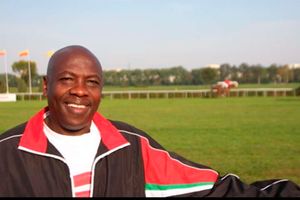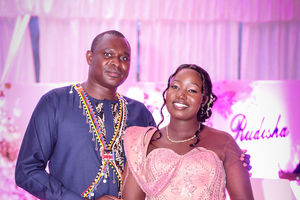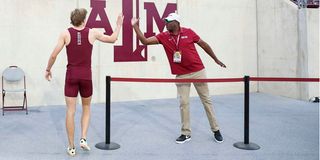
American 800m runner Cayden Norris high-fives Kenyan coach Paul Ereng after racing in the West Preliminary Championships at the Texas A&M university stadium on May 27, 2025.
Paul Ereng was the surprise winner of the 1988 Seoul Olympic Games men’s 800m, surging to the front on the home straight to floor a quality field. He briefly ruled the men’s 800m, winning at the 1989 World Indoor Championships in a new indoor world record of 1:44.84.
He retained his world indoor title in Seville in 1991 but could only manage a fourth place finish at the Tokyo World Championships that year. He was eliminated in the semi-finals of the 1992 Barcelona Olympic games then faded from the global scene.
Today, he is one of the most sought after athletics coaches in America. Daily Nation caught up with the 58-year-old assistant coach of the Texas A&M University which he joined in 2022 after working at University of Texas at El Paso for over two decades.
Q. You represented Kenya at the 1988 Olympic Games while a young university student and went on to win 800m gold. Tell us about that journey.
A. I never thought that I would make history but in 1987, when I joined Virginia University on a sports scholarship I set a first goal of winning the NCAA (National Collegiate Athletic Association Championships). My second goal was to represent Kenya at a global event and this happened to be the Olympic Games. I travelled back to Nairobi and made the team. The next goal was to make it to the finals in Seoul.
Having made it, I must confess, my goal was to finish among the top three. If you watch the race, I was trailing but at the last 200m, I felt strong and started surging forward. On the home stretch I told myself I could win this race. I kept my focus, and that is how I have managed my life. I set goals, one step at a time.
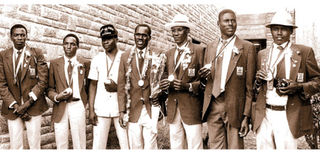
The 1988 Olympic medal winners (from left) John Ngugi (5,000m, gold), Peter Rono (1,500m, gold), boxer Chris Sande (middle-weight, bronze), Peter Koech (3,000m steeplechase, silver), Julius Kariuki (3,000m steeplechase, gold), Paul Ereng (800m, gold) and Kipkemboi Kimeli (10,000m, bronze).
Q. Winning gold at just 21 years must have been a life changing achievement?
A. Yes, my status changed. When we returned to Nairobi, my former school, Starehe Boys High School organised for their students and teachers to receive me at the airport (Jomo Kenyatta International Airport). They just wanted to see their former boy who had conquered the world.
NBC Television from the US came to Kenya and did a documentary about me and my life. This poor rural boy who ended up getting admitted to a prestigious city school and my athletics journey from 400m running to 800m. There was a lot of exposure for me in the media in the US and it opened more opportunities from me.
Q. So how did you switch to coaching?
A. First, I felt like coaching was giving care to upcoming athletes. Having benefited from the same before, knowing that for all my victories there were people behind the scenes including coaches, who had worked just as hard. Without them I wouldn’t have made it. I also thought of giving back to a sport that made me.
This really motivated me to become a coach. World Athletics – then they were the International Association of Athletics Federations, approached me to work at their performance training centre. I did not take up the offer but them approaching me really made me think a lot about coaching. So, I entered this field eventually qualifying with a world athletics coaches education Level II for middles distance, road races and walks.
Q. Your students must be in awe of you?
A. When I look at what I did, I still have top times in the world and collegiate competitions, and when I use that data and talk to the kids, they listen keenly and follow what I tell them. They see what I have achieved, and I did it by doing what I am teaching them, and it motivates them.
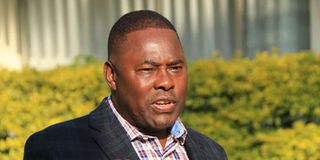
Paul Ereng during interview in Nairobi on July 15, 2016.
Q. From the time you started out at the University of Texas, you have handled many athletes in many institutions in the US. What sets Texas A&M University apart from the others in terms of their approach to track and field.
A. Texas A&M University has a history of track and field and it goes back to the early 1900.They have built the tradition of caring for athletes and that is why we have some of the best modern facilities that translates to good performance. The institution is serious on supporting athletes both academically and sport wise making sure they are being mentored at the top level.
Q. What qualities do you feel an athlete needs to succeed?
A. An athlete needs discipline which comes from a different perspective through training, nutrition, how you sleep, people who are helping you and how you train. All these combined together will bring longevity. A good example is marathoner Eliud Kipchoge, who is disciplined and is under someone very experienced, Patrick Sang, who is an old boy of Texas Tech University.
Q. But how do you help athletes cope with the pressure to perform?
A. You have to understand psychology because everybody feels the pain of failure or disappointment and the relentless expectation to exhale. Athletes need to understand all these and prepare to their best ability. They have to understand the conditions they are in, the race conditions and be ready for anything. As coaches we have to repeat these issues over and over again. It is how they cope that is key.
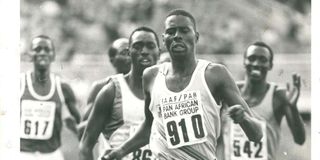
Paul Ereng charges to victory ahead of Billy Konchellah during a race at Moi International Sports Centre, Kasarani.
Q. How do you rate the state of Kenyan middle distance running now and during your days?
A. Some of us had a lot of support from outside Kenya and we had people like Wilson Kipketer who managed to represent Denmark in the distance. When you have the syllabus of a certain subject, it’s all the same and it only depends on how you teach as a tutor. The same applies in the athletics world, and that is why we witness different results. Although there is a scientific part of it, athletics is artistic because running is part of culture. Kenya has amazing athletes and it is just a matter of understanding each individual runner.
Q. Are there specific Kenyan talents you have supported?
A. I remember before I came to the US I had a small training club called Eldoret Track and Field, and Gregory Konchella and John Litei are some of the products that I managed to support. Emmanuel Korir, Michael Saruni and others, who studied at universities in the US, are some of the top athletes I have supported. I am ready to bring more on board and help them in their running careers because someone held my hand before.
Q. What is your advice to young athletes who want to embrace education and sports?
A. Education in the US is so expensive but the athletes who came under athletics scholarship programmes have seen their lives change and they have been even able to support their families back at home. The athletes have better facilities here and if they have the talent they can make it to the Olympic Games. We have had an influx of Kenyan athletes coming to the US. Yes, they run but eventually go back home as professionals in different fields. I graduated with a bachelor's degree in religious studies with a minor in sociology, and here I am.


